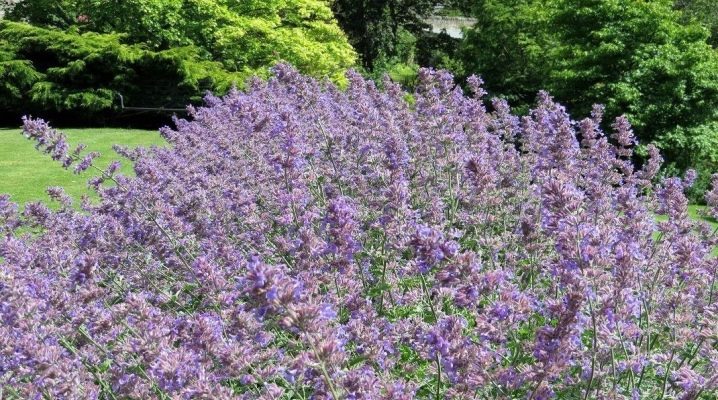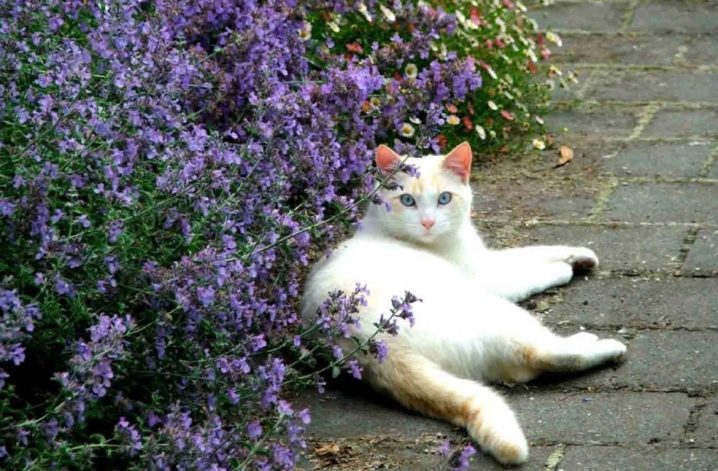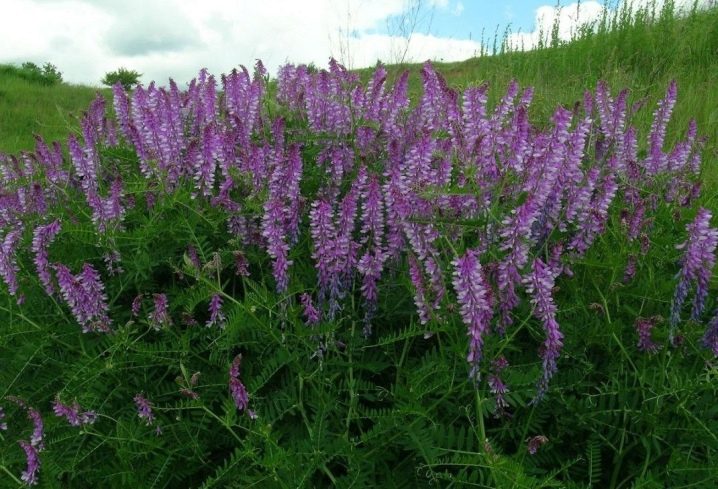What does a catnip look like and how to grow it?

Catnip is considered a fairly common medicinal plant. In addition, it has a pleasant aroma and decorative look. Today we will talk about the features of this vegetation, about the rules for planting and growing it.
general description
Catnip (catnip) got this name for a reason. Cats are crazy about this vegetation. It grows throughout Asia and Europe. There are also special resistant varieties that are grown in Siberia and the Caucasus.
Catnip represents perennial plant (there are also annual specimens). The average height of such a plant is about 1 meter. It looks like a bush with single heart-shaped leaves. It is they who exude a pleasant characteristic aroma.


It should be noted that the aroma of leaves and shoots may differ depending on the specific variety. Some are dominated by spicy notes, others - citrus. In any case, they attract cats and cats.
Catnip flowers gather in whorled inflorescences. The crown of the plant is blue or white, sometimes it is yellow. The fruits are represented by small nuts.
The catnip has many useful properties. It has a calming effect on the organs of the digestive system. In addition, the plant helps to liquefy phlegm. In this case, infusions are used. Often, formulations prepared on the basis of such a plant are used as a tonic.

Views
This catnip can be of various types. Let's analyze the features of some of them.
-
Mussini... This species is a perennial bush, its height reaches 40-45 cm. It grows quite strongly in diameter. The flower buds of the vegetation are blue-violet, they gather in irregular inflorescences. The thin, fragrant foliage has a wrinkled surface. Her colors are gray-green. The variety is often used in the creation of medicinal formulations. Moreover, it is collected during the flowering period. Can be used in crushed form as an aromatic seasoning or spice. Mussini's cattle is very common in the Caucasus.

- Siberian large-flowered catnip. This perennial shrub reaches an average height of 60-70 centimeters. Its shoots are covered with thin leaf blades and large flower buds. The flowers are most often blue or blue-violet in color. The flowering of the plant begins in mid-summer, it ends at the end of the season. This species can be found on the territory of the Crimea, the Baltic States and the Caucasus. It can also be grown in Siberia. On the basis of such vegetation, various anti-inflammatory drugs are prepared.

- Hungarian catnip... This variety has a straight and bare stem. It is slightly pubescent along its entire length. Its height reaches 100-130 cm. The Hungarian catnip blooms with purple small buds that gather in inflorescences. The flowering period lasts from late June to September. This variety is common from Asia to Belarus. It can also be found in the Crimea. As a rule, it grows on road shoulders, slopes.

- Fassen's Catman... This decorative variety grows up to 50 centimeters. It is a beautiful shrub with triangular silvery green leaves. The species is distinguished by abundant flowering, which begins in mid-May and ends at the end of September.The petals are pink or blue-violet in color. The species attracts bees and other beneficial insects, while repelling mosquitoes. Fassen's catnip grows in dry and well-lit areas.
It is perfect for growing a house in pots.

- Vegetable catnip (Centaur). This variety is a stunted perennial. Its height is no more than 40 centimeters. Young shoots, foliage and flowers of the plant have a very strong lemon-spicy smell. They are full of useful vitamins and minerals that are not lost even after drying. Vegetable catnip is often used fresh in the preparation of salads and various desserts. It is also used as a flavoring additive in tea and other beverages.

- Lemon Catnip (Velvet). This medicinal plant is widespread in Asia, Europe and Africa. It has a woody root system. The vegetation is distinguished by a pubescent stem of a light green color. Lemon Catnip also has leaves pubescent on both sides. The foliage is triangular-ovate, with a heart-shaped base. The buds are small, white, sometimes pink specimens are found. The fruits look like small oval-shaped nuts, their color is most often brown, but sometimes they are black.

- Veined catnip... Plants of this species have vertical and ribbed shoots, light green leaves, covered with light pubescence. Throughout the summer, dense inflorescences are formed on the tops of the shoots, consisting of delicate flowers of lilac or blue color. This veined vegetation reaches a height of 30 to 40 centimeters.

- Catnip. The species has low decorative qualities. It is often found in the wild. An adult bush is no more than 90 cm in height. The plant has straight stems, light green shoots, leaves with slight pubescence. The edges of each leaf blade are serrated. During flowering, the bush is covered with small pink flowers. This plant blooms throughout the summer season. The catnip attracts bees and butterflies. At the same time, it scares off mice, mosquitoes and moles. The variety can fully grow on almost any soil. This catnip is often used in the preparation of medicines. In this case, the raw materials should be collected at the end of summer.

Landing
Let's figure out how to plant a catnip correctly. The culture is considered absolutely unpretentious, it can grow on almost any soil. Often, catnip is planted in the near-trunk zone near fruit trees. But in any case, good drainage will be needed.
The best option for a plant will be a well-lit area, protected from cold winds and drafts.... The landing site must be well dug up and completely cleaned of plant debris and weeds.
After that, the soil can be slightly deoxidized, for which lime or dolomite flour is used. These components must be thoroughly mixed with earth.

Catnip seeds tend to look like medium-sized brown grains. Their shape is oval. Before planting, the seed must be stratified in the freezer. And also it must be pre-soaked in warm clean water for 24 hours, this procedure will accelerate germination.
The material can be sown directly into open ground. Sometimes the seeds are first planted in special seedling boxes. A soil mixture with organic nutrients is poured into the container in advance. Then the seeds are laid out there, they are slightly deepened, and covered with clean river sand. The first shoots should appear in about a couple of weeks.
When the sprouts get a little stronger and grow up, they can be transplanted to a permanent place. At the same time, it is necessary to maintain a distance between plants of 40-45 cm. The beginning of summer is considered the best period for planting.
At first, young shoots will require periodic weeding and loosening.And also it is worth regularly watering the catnip so that the bushes can take root and become strong.


Care
After planting, the crop needs proper care.
Watering and feeding
Various types of catnip must be watered in a timely manner in dry and hot weather. After planting, the soil around the vegetation is moistened as it dries. At the same time, moisture stagnation in the roots should not be allowed. It is better to water young bushes once every 7 days. As the crop grows, it will need less and less watering.
Too nutritious soil will have a bad effect on the growth of catnip, therefore, in the first few years after planting, this vegetation, in general, will not need fertilizers. Only after 4-5 years, the bushes should be well mulched with a mass consisting of compost and leafy soil. Additionally, you can use complex dressings to increase the flowering period.

Pruning and wintering
After the flowering period, the shoots as well as the stems should be cut shortly. This procedure will stimulate the growth of the catnip. Timely pruning of old inflorescences prevents self-seeding of the plant.
Often, such a procedure is carried out in order to collect raw materials for the preparation of medicines. In this case, pruning is performed in separate parts during the flowering period. Moreover, a few days before this, the bushes are well watered. Harvesting is recommended in dry and sunny weather.
Remember that a bush cut to the root is very difficult to overwinter, so it is worth leaving shoots about 10 centimeters high. Also, you should not cut the plants too much in late autumn.
In the second half of the autumn season, the bushes should only be cut by 2/3 parts so that they can survive the winter and develop normally next spring. If the catnip is grown in the northern regions, then for the winter it be sure to cover with spruce branches or a special covering material.

Transfer
Every 3-4 years the catnip is recommended to be transplanted to a new place, since with age such a plant begins to lose its decorative effect, flowering decreases over time, shoots thin out. In this case, the mother plant must be divided into several parts.
The dug out earthen lump should be soaked in water for one hour, so as not to injure the vegetation and it would be easier to untangle the root system... Each separated part should have 1-2 shoots, formed roots.
The separated parts must be placed in pre-made holes and thoroughly watered. In the first month, the planted plants require regular moisture. When planting in the fall, you can additionally, mulch the soil around the bushes with sawdust or grass. This will prevent the roots from freezing.

Reproduction
Catnip can be propagated in several ways.
- Growing from seeds. In this case, the seed is sown on the site, or sown on seedlings. You can use self-harvested or purchased processed seeds.
- Dividing the catnip... In this case, the division of adult specimens is performed. Remember that flowering plants will not work for this procedure.
- Cuttings... Cuttings are separated from adult plants in late spring, while the lower cut is formed oblique, the upper cut is straight. The cuttings should be about 10-12 centimeters long. Cutting is recommended to be carried out before the formation of flower buds. For a more effective result, the base of the cuttings should be placed in a special rooting powder.
- Air layering... For such reproduction, the lateral shoots of the catnip are bent to the soil and fixed there with several staples. This technique allows you to end up with several young plants at once. The procedure is carried out in late spring or early summer.

Diseases and pests
The cattleman rarely suffers from infections. Sometimes it is affected by powdery mildew. It damages foliage and shoots.Most often, the infection develops in high humidity and high temperatures. To cure a catnip, you must first rip off all diseased parts. Then it is treated with ready-made fungicides.
Sometimes on the catnip you can see whiteflies and ticks. These parasites affect foliage as well as young shoots. Over time, these parts begin to darken and dry out. In this case, it is necessary to use a simple solution of acaricides or insecticides. It is sprayed only in calm and dry weather.
Remember that fragrant leaves and stems are very attractive for cats, so they can destroy the plant. If you have a large number of animals at home, then the plant can be protected with a mesh fence.

Application in landscape design
Many varieties of catnip are distinguished by their decorative qualities. Often, several bushes are planted along the edges of the garden paths. In this case, it is better to use plants that bloom with beautiful bright buds of purple, blue flowers. If desired, they can be combined with short green spaces, as the catnip goes well with other plantings. Vegetation can be planted simply in open ground or in flower beds.

And you can also create in your summer cottage a whole beautiful composition with a lush catnip and other flower plants of a similar shape. Moreover, they can all be planted in a large flower bed made of decorative stones.
If the site is large, then you can make several such compositions at once.

Often, tall catnipes with purple flowers are planted around summer cottages. They can also be combined with short ornamental grass and green arches. You can plant catnip right on a rocky surface.








The comment was sent successfully.